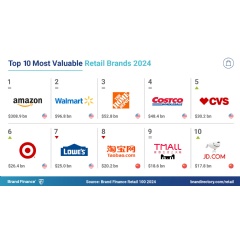Brand value of discount retail brands increases as customers cut spending

- Eight of the world’s top 10 retail brands have seen their brand value decline this year; Amazon maintains its global top spot
- Retail sector in emerging markets grows while major economies shrink
- Big shifts among the world’s strongest retail brands: Bunnings and Decathlon take the lead
- Lazada grows 40% to become the fastest growing retail brand in the world, followed by Metro and Chedraui
Amazon Brand value increased by 3% to $308.9 billion. thereby reaffirming its position as the most valuable retail brand in the world. because new data from Brand Finance suggests that American retailers are struggling to maintain their brand equity. Well-known names such as Walmart (-15% to USD 96.8 billion) and Home Depot (-14% to USD 52.8 billion) maintained their second and third place respectively despite declining brand values.
Discount and cheaper brands like Money Tree (Brand value increased by 23% to USD 5.1 billion), Ross Dress for Less (Brand value increased by 18% to USD 5.1 billion), Family Dollar (brand value increased by 15% to USD 3.2 billion) and Great Britain’s B&M (brand value up 19% to $2.3 billion) all reported improved brand value, reflecting a shift in consumer brand preferences in response to inflation and cost of living pressures.
Annie Brown, General Manager, UK Consulting, Brand Finance, commented:
“Brand Finance research shows a clear trend, with major economies seeing a decline in overall brand values across the industry: 3% in the US, 22% in China, 4% in Germany, 12% in the UK and 9% in Japan. In contrast, our Retail 100 2024 ranking shows growth in brand values in emerging markets: overall brand value in Mexico increased by 38%, in Italy by 18%. Among the fastest-growing brands this year are Mexican brand Chedraui and Italian brand Conad, whose brand values increased by 33% and 27% respectively.”
With a Brand Strength Index (BSI) value of 88.2 out of 100 and a corresponding AAA rating, Australia’s Bunnings is the strongest retail brand in the world. According to a study by Brand Finance, Bunnings scored highly in several areas, including advertising and word of mouth, with 70% of respondents in Australia saying they had talked about the brand. Decathlon ranks second in brand strength with a BSI score of 87.3 out of 100 and a AAA rating and continues to score very well in terms of employee perception (customer service), trustworthiness and reputation, and impresses in terms of value for money and loyalty.
Lazadaone of the largest e-commerce providers in Southeast Asia, is now the fastest growing retail brand in the worldwith a 40% increase in brand value to USD 2.1 billion. In 2023, Lazada launched its value offering “Choice” with the aim of competing with value brands such as Temu and Shein. With a 39% increase to USD 3.0 billion, metro is the second fastest growing retail brand in the world, followed by Chedraui in third place with an increase of 33% to USD 2.1 billion.
India, an important emerging market, is conspicuously absent from the top 100despite its economic size and growing global importance. However, India’s retail sector is poised for rapid growth, with forecasts suggesting it could cross the $2 trillion mark by 2030 or 2032, making it a market to keep a close eye on in future rankings.
About Brand Finance
Brand Finance is the world’s leading brand valuation consultancy. For more than 25 years, Brand Finance has been bridging the gap between marketing and finance. The company assesses the strength of brands and quantifies their financial value to help organizations of all types make strategic decisions.
Headquartered in London with offices in over 20 countries, Brand Finance offers its services on every continent. Each year, Brand Finance conducts more than 5,000 brand valuations, supported by its own market research, and publishes over 100 reports evaluating brands from all industries and countries.
Brand Finance also operates the Global Brand Equity Monitor, which conducts market research on over 5,000 brands annually, surveying more than 150,000 respondents across 38 countries and 31 industries. By combining perception data from the Global Brand Equity Monitor with data from its valuation database, Brand Finance can equip brand leaders with the data and analytics they need to increase brand and business equity.
Brand Finance is a regulated accounting firm that is leading the way in standardizing the brand valuation industry. Brand Finance was the first firm to be certified by independent auditors to both ISO 10668 and ISO 20671 and has received official recognition from the Marketing Accountability Standards Board (MASB) in the United States.
Definition of the brand
A brand is an intangible asset in the context of marketing. This includes names, terms, signs, symbols, logos and designs that serve to identify goods, services or companies, create distinctive images and associations in the minds of stakeholders and thereby generate economic benefits.
Brand strength
Brand strength is the effectiveness of a brand’s performance relative to its competitors on intangible metrics. Brand Finance assesses brand strength using an ISO 20671 compliant process, looking at marketing investments, stakeholder equity and their impact on business performance. The data used comes from Brand Finance’s proprietary market research program and publicly available sources.
Each brand is assigned a Brand Strength Index (BSI) score out of 100, which is used in the brand value calculation. Based on the score, each brand is assigned a corresponding brand rating up to AAA+, in a format similar to a credit rating.
Approach to brand valuation
Brand Finance calculates the value of the brands in its rankings using the Royalty Relief approach – a brand valuation methodology that complies with industry standards set out in ISO 10668. It estimates the expected future revenue attributable to a brand by calculating a royalty fee that would be charged for its use. This produces a “brand value”, which is understood as the net economic benefit that a brand owner would receive by licensing the brand on the open market.
The steps in this process are as follows:
1 Calculate brand strength using a balanced scorecard with metrics that assess marketing investment, stakeholder equity and business performance. Brand strength is expressed as a Brand Strength Index (BSI) score on a scale of 0 to 100.
2 Determine the royalty rate range for each industry that reflects the importance of the brand in purchasing decisions. In the luxury sector, the maximum percentage is high, while it is lower in the commodity industry, where goods are often commodified. This is achieved by reviewing comparable royalty agreements from Brand Finance’s extensive database.
3 Calculate royalty rate. The BSI score is applied to the royalty rate range to determine a royalty rate. For example, if the royalty rate range in a sector is 0-5% and a trademark has a BSI score of 80 out of 100, then a reasonable royalty rate for use of that trademark in that sector is 4%.
4 Determine brand-specific sales by estimating the proportion of the parent company’s sales that can be attributed to a brand.
5 Determine projected earnings using a function of historical earnings, stock analyst forecasts, and economic growth rates.
6 Apply the royalty rate to the projected revenue to determine brand revenue.
7 Discount the after-tax brand revenues to a net present value that equals the brand value.
Disclaimer
Brand Finance has prepared this study using independent and unbiased analysis. The values derived and opinions presented in this study are based on publicly available information and certain assumptions used by Brand Finance where such data was inadequate or unclear. Brand Finance assumes no responsibility and shall not be liable in the event that the publicly available information relied upon later turns out to be inaccurate. The opinions and financial analyses expressed in the study are not to be construed as investment or business advice. Brand Finance does not intend the study to be relied upon for any reason and disclaims any liability to any entity, government or organization.
The data presented in this study is part of Brand Finance’s proprietary database, is provided for the benefit of the media and may not be used in whole or in part for commercial or technical purposes without the written permission of Brand Finance.
This news content was configured by the WebWire editorial team. Linking is permitted.
Services provided by WebWire for the distribution of press releases and press releases.



